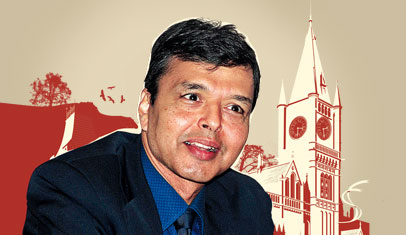| ||||||||||||||||||||
"Regulators
should recognise the diversity of students and offer flexibility to institutions”
22
October 2010
Abhijit Mukherjee has been the director of Thapar University
since 2006—and his long stint has given him the experience to realise that quality
is the key, if there is to be progress in the higher education sector. He tells
EDU about what it will take to increase our GER, with quality

The target of achieving a GER of 30 percent by 2020 is undoubtedly a stiff one—but we must do our best to reach that goal because we have no other option. With regard to the role of quality in increasing the gross enrolment ratio—with scaling up we should be ready to accept variable output. More importantly, institutions must have different “enrichment goals” for students coming in from different sectors; those who leave school with strong mathematics and analytical skills can be shaped into great market analysts or researchers. At the same time, there should be a significant demand for positions that require not high mathematics, but sector knowledge, diligence and discipline. The educational institutions should articulate these goals; what kind of students they cater to, and what value-addition they promise.
Programmes should be tuned to social realities and needs—to ensure quality the first step should be to take stock of the surroundings and see what are the core capabilities of an institute. Our regulators should recognise the diversity (of students in India) and offer flexibility to institutions, rather than centrally dictating requirements and processes. The institutions may be ranked on what value addition they have achieved through the students. That would be a shift from the present norms such as land area, constructed space, et all. One must appreciate that the question of quality (of education) must be judged by its purpose. Thus, there can be no single yardstick (or value) that may be adjudged as the best. The dilemma is to fix a goal. What are the social realities? What is the target enrichment? What kind of people (students and faculty) would one like to work with? What are the best practices to reach there? Once decided on the imperatives, the planners must articulate them clearly, and choose the right enablers. For example, if an institute is located in an area with engineering enterprises and if the university expects its students to come from that area—then it should ideally offer such training that the students can later join the local industries.
Success (of the institute and students) must be measured by the success of both in that target sector (local industries). Quality must be like a mantra. It must be imbued into an institution’s ecosystem and culture. An important component is to define it in measurable terms and keep monitoring an institution’s individuals and sections, and the institutions as a whole, to understand the progress. There must be tangible benefits for adhering to high quality. On a personal note, I can cite Thapar University as an example—the University set the creation of knowledge as its prime goal. I clearly declared what I wanted from its faculty and began to measure their performance on parameters such as publication, PhD theses and research grants. A department’s rank was published. The faculty have jointly decided the target for the next year based on previous year’s data. The recruitment policy is based on these requirements. Budget allocation was based on targets and performances. Individuals are felicitated with substantial financial benefits.
Finally, the university’s targets are decided and its
performance monitored. Within three years, there is a perceptible change not only
in the numbers but also in the culture of the University. Institutions have to
delicately balance the imperatives of growth and quality. They must study assets
and societal needs; set goals every year; and devise mid-course corrections. Standards
must be compatible with goals—which must receive budgetary support. It must be
remembered that educational institutes have a long gestation period and budgeting
must be decided accordingly.




